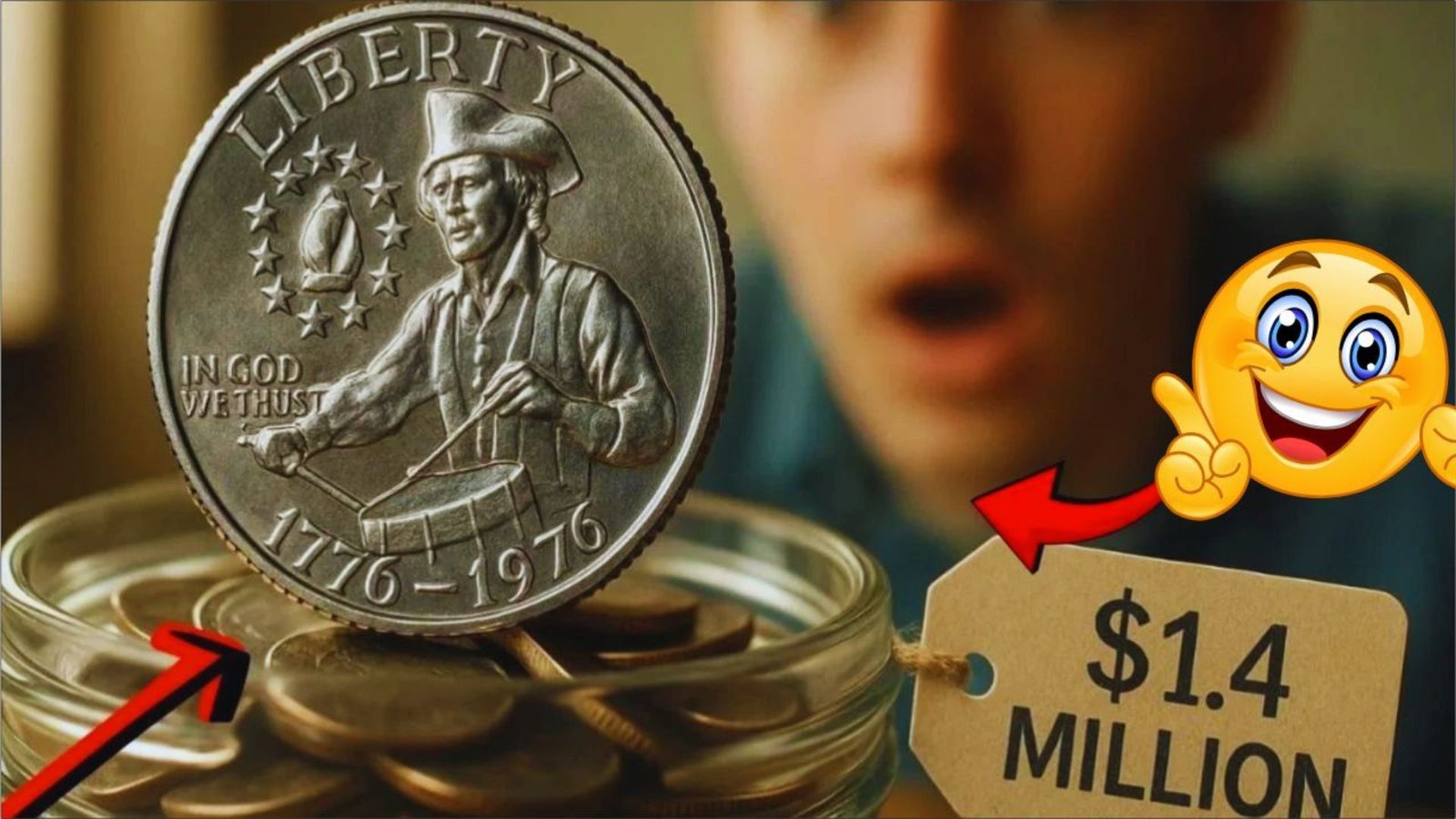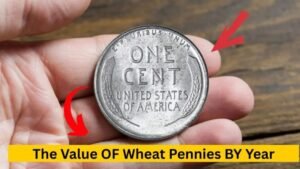In a surprising turn of events, a rare 1976 Bicentennial Quarter, discovered in an ordinary coin jar, has sold for an astonishing $1.4 million at auction. This remarkable find has captured the attention of coin collectors and enthusiasts worldwide, highlighting the potential for valuable treasures to be hidden in everyday places.
we’ll explore the story behind this incredible discovery, why this quarter is so valuable, and how you can start looking for rare coins in your own collection. Optimized for search engines, this guide is written in simple, easy-to-understand language to help you grasp the excitement of this find.
What Is the 1976 Bicentennial Quarter?
The 1976 Bicentennial Quarter was minted to celebrate the 200th anniversary of the United States’ independence. Unlike regular quarters, these coins feature a special design with a colonial drummer on the back and the dual date “1776-1976” on the front. While millions of these quarters were produced, certain versions are extremely rare and valuable due to specific minting errors or unique characteristics.
Why Is This Quarter So Special?
The quarter that sold for $1.4 million wasn’t just any Bicentennial Quarter—it had unique features that made it a collector’s dream. Here’s why this coin stood out:
- Minting Error: The coin had a rare error from the minting process, such as a double strike or misalignment, which made it one-of-a-kind.
- High Grade Condition: It was in near-perfect condition, graded highly by professional coin grading services like PCGS or NGC.
- Limited Production: Some Bicentennial Quarters, especially those struck in silver or with specific mint marks, were produced in very small quantities.
These factors combined to make this particular quarter a rare gem, driving its value to an extraordinary $1.4 million.
The Discovery: A Coin Jar Treasure
The story of this quarter’s discovery is as fascinating as the coin itself. A person sorting through an old coin jar—likely filled with loose change collected over years—stumbled upon the 1976 Bicentennial Quarter. At first glance, it looked like any other quarter, but something about it caught their eye. Perhaps it was the unusual shine, a strange mark, or an unfamiliar detail. After closer inspection and consultation with a coin expert, they realized they had found something extraordinary.
This wasn’t the first time a valuable coin was found in an unexpected place. Coin collectors often share stories of finding rare coins in piggy banks, old drawers, or even at flea markets. The $1.4 million sale of this quarter serves as a reminder that hidden treasures might be closer than you think.
How Was the Coin Authenticated?
Once the coin was discovered, it was sent to a professional grading service to verify its authenticity and condition. Here’s how the process works:
- Inspection: Experts examine the coin for minting errors, wear, and overall condition.
- Grading: The coin is assigned a grade on a scale from 1 to 70, with 70 being perfect condition.
- Certification: A certificate of authenticity is issued, confirming the coin’s value and rarity.
In this case, the quarter was graded as one of the finest examples of its kind, which significantly increased its auction value.
Why Do Rare Coins Sell for So Much?
Rare coins like the 1976 Bicentennial Quarter can fetch millions because of their scarcity and demand among collectors. Here are some key factors that drive up a coin’s value:
| Factor | Explanation |
|---|---|
| Rarity | Coins with limited production or unique errors are harder to find. |
| Condition | Coins in excellent condition, with minimal wear, are more valuable. |
| Historical Significance | Coins tied to important events, like the Bicentennial, attract more interest. |
| Collector Demand | High demand from collectors can drive up prices at auctions. |
| Material | Coins made of precious metals, like silver, are often worth more. |
The $1.4 million quarter checked all these boxes, making it a perfect storm of value and desirability.
How to Spot a Valuable Coin in Your Collection
Inspired by this story? You might be wondering if you have a valuable coin hiding in your own coin jar. Here’s a step-by-step guide to help you identify potential treasures:
- Check for Unique Designs: Look for coins with special designs, like the Bicentennial Quarter’s colonial drummer.
- Examine Mint Marks: Mint marks (like “S” for San Francisco) can indicate rarity.
- Look for Errors: Misprints, double strikes, or off-center designs can make a coin valuable.
- Assess Condition: Coins with little wear or damage are worth more.
- Research Values: Use online resources or consult a coin dealer to check current market values.
Tools You’ll Need to Start Coin Collecting
If you’re new to coin collecting, here’s a quick list of tools to help you get started:
- Magnifying Glass: To inspect coins for errors or unique marks.
- Coin Guides: Books like the “Red Book” (A Guide Book of United States Coins) provide detailed information.
- Coin Holders: To protect your coins from damage.
- Grading Service: Professional services like PCGS or NGC for authentication.
The Auction: How the Quarter Sold for $1.4 Million
The rare 1976 Bicentennial Quarter was sold at a high-profile auction, where collectors and investors competed fiercely to own it. Auctions for rare coins often attract wealthy buyers who see these items as both historical artifacts and investments. The bidding started at a modest amount but quickly escalated as bidders recognized the coin’s rarity and pristine condition.
What Happens at a Coin Auction?
Coin auctions are exciting events where rare coins are sold to the highest bidder. Here’s how they typically work:
- Catalog Listing: The coin is listed with a detailed description and estimated value.
- Bidding Process: Bidders place offers, either in person, online, or by phone.
- Final Sale: The highest bid wins, and the buyer pays the auction house, which may include a buyer’s premium (an additional fee).
In this case, the quarter’s unique features and high grade drove the final sale price to $1.4 million, making headlines across the coin-collecting world.
Tips for Starting Your Own Coin Collection
If this story has sparked your interest in coin collecting, you’re not alone! Here are some beginner-friendly tips to help you dive into this rewarding hobby:
- Start Small: Begin with coins you already have, like spare change or inherited collections.
- Learn About Coins: Read books or join online forums to understand coin types, mint marks, and values.
- Network with Collectors: Attend coin shows or join local coin clubs to meet other enthusiasts.
- Store Coins Properly: Use acid-free holders or albums to keep your coins safe.
- Be Patient: Building a valuable collection takes time, but the hunt is part of the fun!
Where to Find Rare Coins
You don’t need to search far to start your coin-collecting journey. Here are some places to look:
- Coin Jars: Check your own spare change for hidden gems.
- Flea Markets: Vendors may unknowingly sell rare coins at low prices.
- Estate Sales: Old collections often surface at estate sales or auctions.
- Coin Shops: Visit local dealers for expert advice and rare finds.
- Online Marketplaces: Websites like eBay or Heritage Auctions offer coins, but be cautious of fakes.
The Future of Coin Collecting
The sale of the $1.4 million Bicentennial Quarter has reignited interest in coin collecting, proving that rare coins can still fetch life-changing sums. As more people learn about the potential value of coins, the hobby is likely to grow. Advances in technology, like online auctions and grading services, have also made it easier for collectors to buy, sell, and authenticate coins.
Why Coin Collecting Is a Great Hobby
Coin collecting isn’t just about finding valuable treasures—it’s also a fun and educational pastime. Here’s why people love it:
- History: Each coin tells a story about the time and place it was made.
- Investment: Rare coins can increase in value over time.
- Community: Collectors share a passion for discovery and knowledge.
- Thrill of the Hunt: Finding a rare coin feels like uncovering buried treasure.
Conclusion
The discovery of a 1976 Bicentennial Quarter in a simple coin jar, sold for $1.4 million, is a reminder that treasures can be hiding in plain sight. This rare coin, with its unique errors and pristine condition, captured the attention of collectors and made headlines worldwide. Whether you’re a seasoned collector or a curious beginner, this story shows the exciting potential of coin collecting. By learning to spot rare coins, using the right tools, and exploring places like coin jars or flea markets, you might uncover your own valuable find. Start checking your change today—you never know what you might discover!
Frequently Asked Questions (FAQs)
What makes the 1976 Bicentennial Quarter valuable?
The value comes from rare minting errors, high-grade condition, or limited production, like silver versions or specific mint marks.
How can I tell if my quarter is rare?
Check for minting errors, unusual designs, or mint marks (like “S”). Consult a coin guide or professional grader for confirmation.
Where can I sell a rare coin?
You can sell through auction houses, coin dealers, or online platforms like eBay. Always authenticate your coin first.
How do I start coin collecting?
Begin with spare change, learn about coins through books or forums, and invest in tools like a magnifying glass and coin holders.
Are all 1976 Bicentennial Quarters valuable?
No, most are common and worth only face value. Only those with rare errors or in exceptional condition are highly valuable.





1 thought on “Rare 1976 Bicentennial Quarter Found in Coin Jar Sells for $1.4 Million: A Hidden Treasure Uncovered”